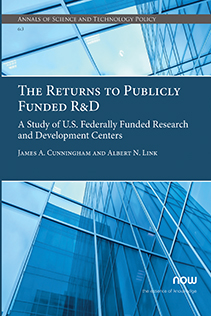The Returns to Publicly Funded R&D: A Study of U.S. Federally Funded Research and Development Centers
By James A. Cunningham, Newcastle University, UK, and Centre for Innovation Research, Lund University, Sweden, james.cunningham@newcastle.ac.uk | Albert N. Link, University of North Carolina at Greensboro, USA, anlink@uncg.edu
Abstract
There is an ongoing policy debate across many countries about the returns to investments in publicly funded R&D. However, much of that debate is based on conjecture rather than empirical facts. Unlike the literature that focuses on the returns to investments in privately funded R&D activity, empirical estimates of the returns to publicly funded R&D are limited.
This monograph focuses on one group of public sector organizations that is not only R&D intensive but also that has the potential to enrich economic growth and development in the United States; namely, Federally Funded Research and Development Centers (FFRDCs). Herein, the limited literature on the returns to public sector returns to R&D is reviewed, this legislative history of FFRDCs is presented, and the social benefits associated with FFRDC research are evaluated. The monograph concludes with policy recommendations about the direction for future research on the returns to publicly funded R&D.
The Returns to Publicly Funded R&D: A Study of U.S. Federally Funded Research and Development Centers
The Returns to Publicly Funded R&D focuses on the returns to U.S. public-sector investments in R&D and the accompanying new empirical analysis relates specifically to the returns to public-sector R&D expenditures in U.S. Federally Funded Research and Development Centers (FFRDCs). One motivation for studying the rates of return to public-sector R&D is the paucity of existing literature on the topic. However, there are two other important motivations for studying the rates of returns to public-sector R&D: a public accountability motivation and a mandated public policy motivation. Although the analysis of investments in R&D in FFRDCs presented herein is econometrics based, there is however a frequently overlooked program evaluation literature that also offers insight into the rates of returns to public-sector R&D. Examples of the program evaluation literature is presented in Section 3 for completeness as well as to illustrate a broader rate of return concept than that presented in the econometrics-based literature. U.S. legislative actions to increase publicly funded R&D in support of private-sector R&D are discussed in Section 4. For the purpose of providing context, a brief history of FFRDCs in the United States is presented in Section 5. FFRDCs have surprisingly been an overlooked element of the public-sector ecosystem that supports public-sector research. An empirical analysis of U.S. public-sector R&D expenditures in FFRDCs, and the associated scientific publications, is presented and discussed in Section 6. Concluding observations about the themes discussed throughout this monograph are offered in Section 7.
